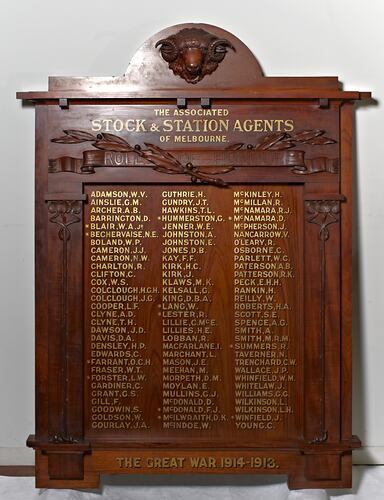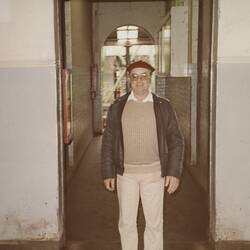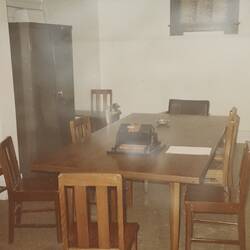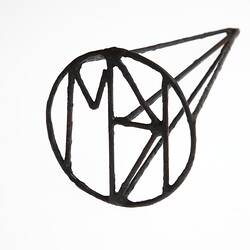Summary
Alternative Name(s): Honour Roll
World War I honour board of polished wood, featuring a carved ram's head and foliage, commemorating the service of employees of Associated Stock & Station Agents of Melbourne. It is one of two almost-identical boards commissioned by this organisation.
The honour board made in 1917 to commemorate the service of workers at the Associated Stock and Station Agents of Melbourne, which was closely linked to the Newmarket Saleyards. It was made by Goldman Manufacturing Co, whose label is on the sister honour board. The carving is similar in style to that of well-known Australian carver Robert Prenzel. It is a significant example of movable commemorative heritage, and is a window to the Newmarket community of the early 20th century.
The board was unveiled on 25 June 1917. Stock and Land (Melbourne) reported that 80 members of the Associated Stock & Station Agents gathered at 3pm in the Board Room, Oxford Chambers, to attend the unveiling 'as a tribute to the men who had gone to the front, and all of whom were at the time of enlisting either employed in the offices or in the general business of the several firms constituting the Association.' The unveiling ceremony was performed by the Hon. Donald Mackinnon, Director-General of Recruiting. It was noted that the names of 76 men were included, painted 'temporarily', and that 'a good many more names' would likely be added before the war ended. After the war it was planned to remove the names and have them 'finally set in gold lettering in alphabetical order'. The board eventually included 90 names. Mr Mackinnon encouraged more men to enlist, and emphasized that 'Even through a soldier took risks of his life and maiming,...a great and rare opportunity was offered to any young fellow - an opportunity to see the world and all that that meant, and to take part in the greatest war that humanity had ever had to wage.'
The duplicate board was unveiled, also by Mr Mackinnon, on 11 July 1917, to be hund in the Association offices at Newmarket. It is now on display at the Victorian Livestock Exchange.
Physical Description
Honour board of polished wood. The board is rectangular, with a semi-circular curved top. At the top of the board, on the curved panel is a 3-dimensional carved ram's head. Written in gold lettering at the top of the board, below the ram's head, is the company name: 'THE ASSOCIATED STOCK & STATION AGENTS OF MELBOURNE'. Below this text is a carved scroll with the words 'ROLL OF HONOUR', and this is overlaid with two carved Art Nouveau-style gum leaf sprays that cross in the centre of the scroll. These carved elements appear to be discretely nailed onto the board. A large wooden panel in the centre of the board bears 90 names of men linked to the Associated Stock and Station Agents, organised in three columns in alphabetical order, and written in gold lettering. Twelve names have an asterisk, which denotes that they were killed in action or died of wounds. The bottom frame of the board bears the words in gold lettering: 'THE GREAT WAR 1914-1918'. The sides of the board are framed by two columns with a carved triple leaf design (possibly an arum lily leaf) at the top that connects by a simple carved vine to a decorative twist at the bottom. A small piece of the decorative twist appears to be missing from the right-hand column. From the back, it appears that the panel of names can slide out by removing a piece of frame that holds it in place. There is no indication of a maker's or manufacturer's mark on the board.
Significance
Statement of significance:
The honour board was made around 1920 to commemorate the service and sacrifice of the community of workers surrounding the Associated Stock and Station Agents of Melbourne, which was closely linked to the Newmarket Saleyards. It is a significant example of movable commemorative heritage, and is a window to the Newmarket society of the early 20th century. The Association was formed in 1888 in response to the booming sales activity at Newmarket Saleyards (which opened in 1861) and appears to have acted as a regulatory body for the Saleyards. By 1914, there were 39 stock and station agents in the Association. The Association's commission of an honour board to display its contribution to World War I enlistment and to pay tribute to its fallen soldiers illuminates the important role that it played as the peak body at the Newmarket community.
The carved ram's head motif is fairly unique to this honour board, and is a statement of the primary trade at Newmarket. The sheep trade in particular was fundamental to the Victorian and Australian economies and a strong part of the national identity as Australia was a leading wool exporting nation. Robert Prenzel, a renowned wood carver, and H Goldman Manufacturing Co, a prominent Melbourne furniture manufacturer, are both possible makers of this board. The board includes a gum-leaf motif that is consistent with Australiana Art Nouveau designs that were popular patriotic statements on large furniture commissions c.1904-1916.
An almost identical board is on display at the Victorian Livestock Exchange in Pakenham. The reason for the duplicate is currently unknown. A possible explanation is that one board was intended to be displayed at the Newmarket office and the other at a Melbourne CBD office, but photographs taken at Newmarket before its 1987 closure show that at that time the two boards hung in different locations within the same building at the Newmarket Saleyards office complex - one in the board room and one in a hallway of the main office. This honour board then passed to the son of the last chairman, and was later sold to a Yarra Glen Antiques Dealer, where it was spotted by a member of the Yarra Glen RSL and secured with a Department of Veterans Affairs grant.
This honour board crosses two key Melbourne Museum collections - the Newmarket Saleyards and the World War I military history collections. This honour board is an entry point to many stories of the Newmarket Saleyards society of the early twentieth century and broader Melbourne society during World War I. It can illuminate some of the impact of the World War I on a community like the Saleyards workforce (both a widespread community and a varied demographic in terms of socioeconomic circumstances). The criteria for being named is not known, but was probably limited to individuals directly involved with working at Newmarket. Ninety able-bodied men left the work of the saleyards to go to war, and twelve of these men did not return. This loss of workforce, whether temporary or permanent, would have had a vast impact on the Saleyards, with many of the serving men listed as trained auctioneers, clerks, drovers and farmers.
Several veterans' heritage reports, such as the Victorian Veterans Unit survey and Department of Veterans Affairs studies have highlighted that honour boards are under threat from poor storage conditions, deliberate defacement or a "recycling" mentality. These threats are heightened when an organisation closes, or moves premises and the boards value is not recognised by those in charge of its fate. This board has itself been under threat of defacement during its lifetime, and is furthermore unable to be displayed by the Yarra Glen RSL. Preservation of this type of war heritage is important, as these relics are significant statements of grief and pride in the war service of Australians.
Research on the duplicate Pakenham honour board by historian Lenore Frost is available at http://empirecall.blogspot.com.au/2010/05/associated-stock-and-station-agents.html.
More Information
-
Collection Names
Newmarket Saleyards Collection, Returned and Services League (RSL) Collection
-
Collecting Areas
-
Acquisition Information
Donation from Yarra Glen Returned Services League (RSL) Sub Branch, 09 Oct 2012
-
Date Made
-
Date Presented
25 June 1917
Presentation date of this honour board. -
Date Presented
11 July 1917
Presentation date for duplicate honour board -
Maker
-
Other Association (See Comments)
Robert Prenzel, Melbourne, Victoria, Australia, circa 1920
Prenzel's work is similar in style to that seen on the honour board. -
Commissioned By
Associated Stock & Station Agents, Melbourne, Victoria, Australia, circa 1920
-
Previous Owner
Yarra Glen Antiques Centre, 8 Bell Street, Yarra Glen, Victoria, Australia
-
Other Association (See Comments)
Victorian Livestock Exchange, Pakenham, Greater Melbourne, Victoria, Australia
Owner and location of sister honour board -
Other Association (See Comments)
Newmarket Saleyards, Newmarket, Victoria, Australia
The honour board was made around 1920 to commemorate the service and sacrifice of the community of workers surrounding the Associated Stock and Station Agents of Melbourne, which was closely linked to the Newmarket Saleyards, and names men who would have worked there. -
Inscriptions
At top in gold: 'THE ASSOCIATED STOCK & STATION AGENTS OF MELBOURNE'. On carved scroll: 'ROLL OF HONOUR'. A large wooden panel in the centre of the board bears 90 names of men linked to the Associated Stock and Station Agents, organised in three columns in alphabetical order, and written in gold lettering. On the bottom of the frame in gold: 'THE GREAT WAR 1914-1918'.
-
Classification
-
Category
-
Discipline
-
Type of item
-
Overall Dimensions
1175 mm (Width), 150 mm (Depth), 1570 mm (Height), 42 kg (Weight)
-
References
Associated Stock and Station Agents Erect Two Honour Boards. (1917, June 27). Stock and Land (Melbourne, Vic. : 1914 - 1918), p. 4. Retrieved December 21, 2015, from [Link 1] Unveiling Honour Board at Newmarket Yards. (1917, July 11). Stock and Land (Melbourne, Vic. : 1914 - 1918), p. 3. Retrieved December 21, 2015, from [Link 2]
-
Keywords
World War I, 1914-1918, Death & Mourning, Livestock Sale Yards, Making History - Newmarket Saleyards



